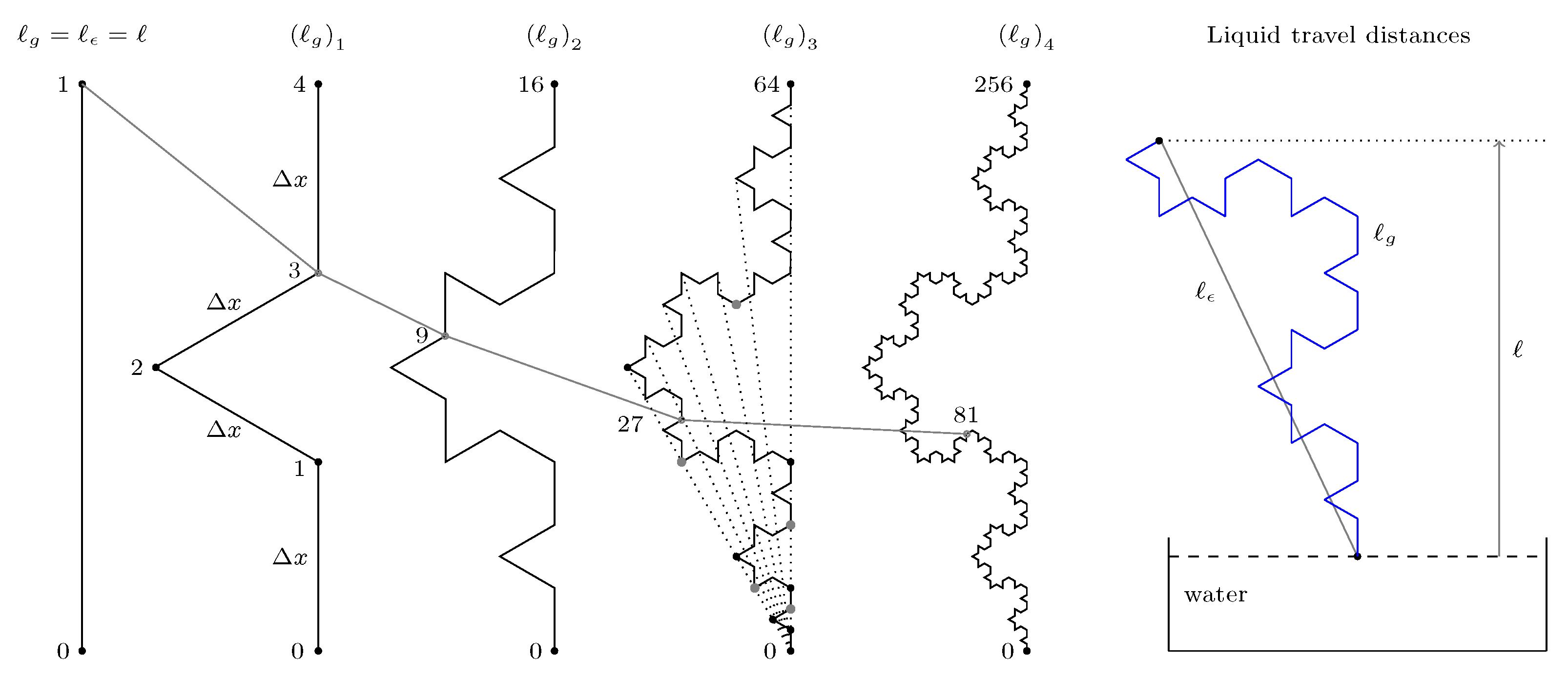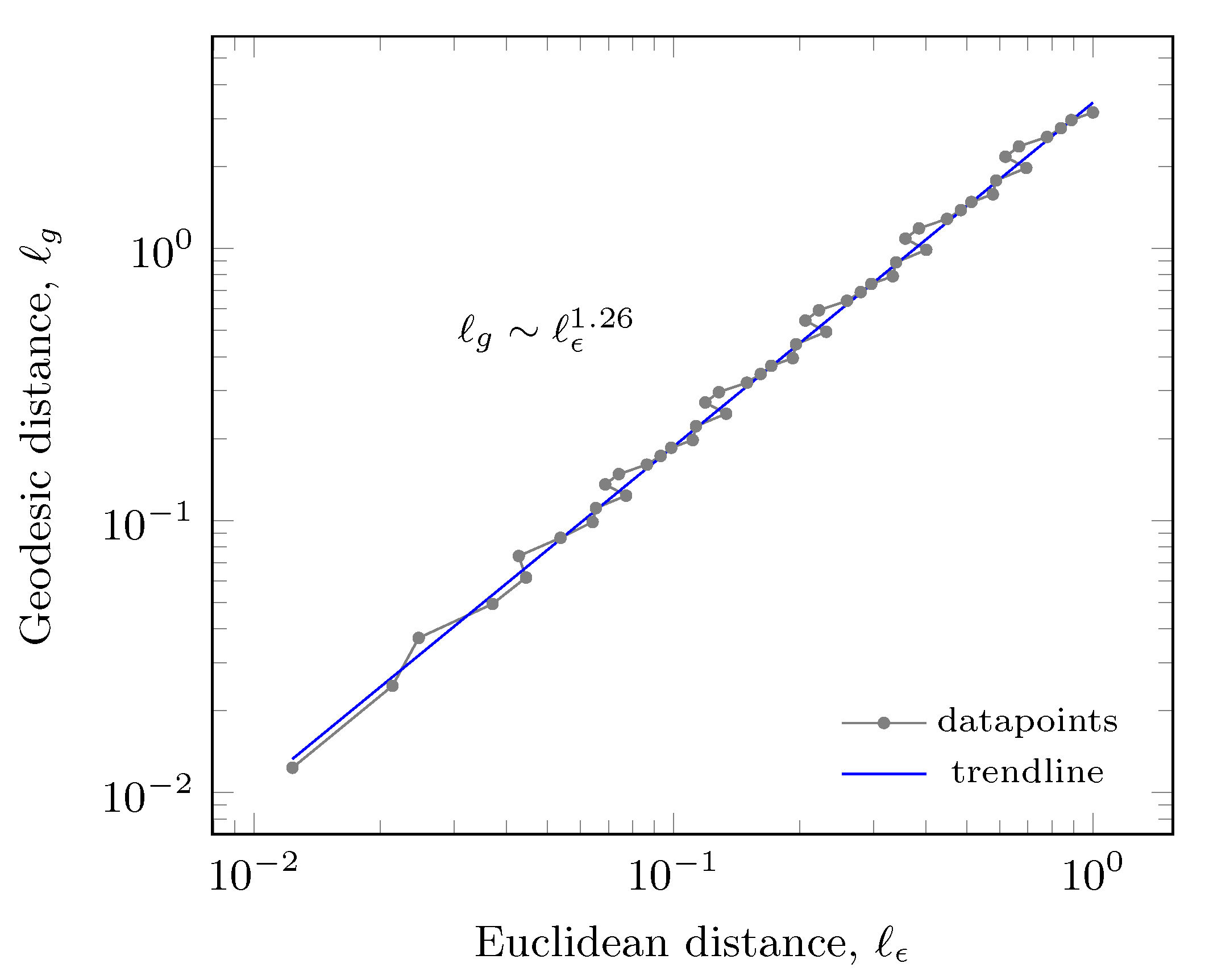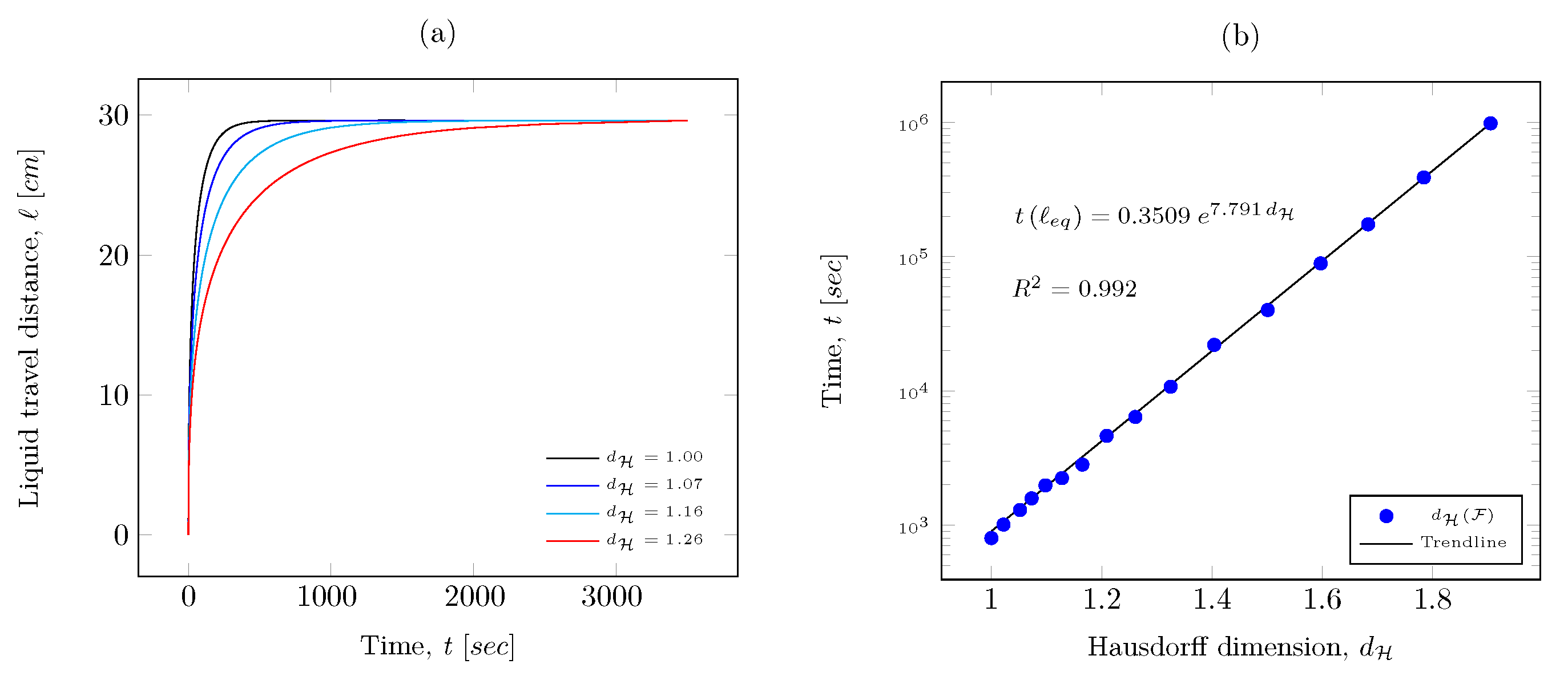The Hausdorff Dimension and Capillary Imbibition
Abstract
:1. Introduction
2. Terminology and Notations
2.1. Classical Differential Equation for Immiscible Imbibition
2.2. Euclidean and Geodesic Metric on Fractal Curves
2.3. Geodesic Dimension and Distances on Self-Avoiding Fractals

3. Standard Differential Equation of Capillary Rise with Geodesic Metric
4. Results Obtained on Capillary Rise on Von Koch Curves
- 1
- The validation of the introduced formulation was performed by comparison of the calculated theoretical values with the experimental results of other authors mentioned above.
- 2
- The formulation can be applied to highly tortuous capillaries. It is adaptable to fractal-curve-like capillaries and it does not depend on their tortuosity (for example, in the case when the capillary is a generalized fractal Koch curve, Weierstrass curve, or any linear fractal with Hausdorff dimension between 1 and 2).
- 3
- The “effective” volume of imbibed liquid can be computed directly using the geodesic distance instead of the imbibition height distance.
- 4
- The developed method is an optimization of the formulation proposed in [61], where . In the proposed method, it is not necessary to calculate neither the tortuosity nor the tortuosity fractal dimension of capillary tubes, it is enough to simply determine their Hausdorff dimension.
- 5
5. Conclusions
Author Contributions
Funding
Data Availability Statement
Acknowledgments
Conflicts of Interest
Abbreviations
| Symbols | ||
| = | Bond number | |
| = | Capillary number | |
| = | Ball diameter with respect to the Euclidean metric | |
| = | Ball diameter with respect to the geodesic metric | |
| = | Geodesic dimension | |
| = | Hausdorff dimension | |
| = | Chemical dimension | |
| = | Hausdorff dimension of the minimum path | |
| = | Hausdorff dimension of the minimum path | |
| = | Topological dimension | |
| F | = | Fractal curve |
| ℓ | = | Height imbibition |
| = | Euclidean distance | |
| = | Geodesic distance | |
| = | Number of | |
| M | = | Viscosity ratio |
| = | Fractal mass | |
| = | Constant of proportionality 1, as defined in Equation (12) | |
| = | Constant of proportionality 2, as defined in Equation (14) | |
| = | Capillary pressure | |
| = | Hydrostatic pressure | |
| = | Capillary pressure | |
| = | Capillary radius | |
| t | = | Imbibition time |
| = | Equilibration time | |
| = | Equilibrium height | |
| Greek letters | ||
| = | Surface tension | |
| = | Viscosity | |
| = | Time scaling exponent | |
| = | Intrinsic permeability of the capillary tube | |
| = | Indentation angle for generalized von Koch curve | |
| = | Exponent, as defined by Equation (26) | |
| = | Wetting liquid density | |
| = | Gas density | |
| = | Constant associated with rock/fluid properties | |
References
- Golmankhaneh, A.K.; Welch, K. Equilibrium and non-equilibrium statistical mechanics with generalized fractal derivatives: A review. Mod. Phys. Lett. 2021, 14, 2140002. [Google Scholar] [CrossRef]
- Mabrouk, A.; Selmi, B. On the topological billingsley dimension of self-similar sierpinski carpet. Eur. Phys. J. Spec. Top. 2021, 230, 3861–3871. [Google Scholar] [CrossRef]
- Samayoa, D.; Damián-Adame, L.; Kryvko, A. Map of bending problem for self-similar beams into fractal continuum using Euler-Bernoulli principle. Fractal Fract. 2022, 1, 230. [Google Scholar] [CrossRef]
- Gowrisankar, A.; Golmankhaneh, A.K.; Serpa, C. Fractal calculus on fractal interpolation functions. Fractal Fract. 2021, 5, 157. [Google Scholar] [CrossRef]
- Yu, B. Fractal dimensions for multiphase fractal media. Fractals 2006, 14, 111–118. [Google Scholar] [CrossRef]
- Yu, B. Fractal character for tortuous streamtubes in porous media. Chin. Phys. Lett. 2005, 22, 158–160. [Google Scholar] [CrossRef]
- Liang, M.; Yu, B.; Yang, S.; Zou, M.; Yao, L. Fractal analysis of hydraulics in porous media with wall effects. Fractals 2014, 22, 1440001. [Google Scholar] [CrossRef]
- Miao, T.; Yu, B.; Duan, Y.; Fang, Q. A fractal analysis of permeability for fractured rocks. Int. J. Heat Mass Transf. 2015, 81, 75–80. [Google Scholar] [CrossRef]
- Miao, T.; Yang, S.; Long, Z.; Yu, B. Fractal analysis of permeability of dual-porosity media embedded with random fractures. Int. J. Heat Mass Transf. 2015, 88, 814–821. [Google Scholar] [CrossRef]
- Miao, T.; Chen, A.; Cheng, S.; Yu, B. A fractal permeability model for porous-fracture media with the transfer of fluids from porous matrix to fracture. Fractals 2019, 7627, 1950121. [Google Scholar] [CrossRef]
- Zhu, Y.; Li, Z.; Ni, J.; Lai, F.; Wu, D. Modeling the spontaneous imbibition of non-Newtonian fluids into the fractal porous media of tight reservoirs. J. Pet. Sci. Eng. 2022, 209, 109892. [Google Scholar] [CrossRef]
- Wu, Z.; Cui, C.; Yang, Y.; Zhang, C.; Wang, C.; Cai, X. A Fractal permeability model of tight oil reservoirs considering the effects of multiple factors. Fractal Fract. 2022, 6, 153. [Google Scholar] [CrossRef]
- Yu, B.; Li, J. Some fractal characters of porous media. Fractals 2001, 9, 365–372. [Google Scholar] [CrossRef]
- Balankin, A.S.; Patino-Ortiz, J.; Patino-Ortiz, M. Inherent features of fractal sets and key attributes of fractal models. Fractals, 2022; in press. [Google Scholar] [CrossRef]
- McCurdy, E. Leonardo da Vinci’s Note-Books; Duckworth: London, UK, 1906. [Google Scholar]
- Washburn, E.W. The dynamics of capillary flow. Physical Review 1921, 17, 273. [Google Scholar] [CrossRef]
- Laughlin, R.D.; Davies, J.E. Some aspects of capillary absorption in fibrous textile wicking. Textile Res. J. 1961, 10, 904–910. [Google Scholar] [CrossRef]
- Delker, T.; Pengra, D.B.; Wong, P.Z. Interface pinning and the dynamics of capillary rise in porous media. Phys. Rev. Lett. 1996, 76, 2902. [Google Scholar] [CrossRef]
- Lam, C.H.; Horváth, V.K. Pipe network model for scaling of dynamic interfaces in porous media. Phys. Rev. Lett. 2000, 85, 1238–1241. [Google Scholar] [CrossRef] [Green Version]
- Li, K.; Chow, K.; Horne, R.N. Influence of initial water saturation on recovery by spontaneous imbibition in gas/water/rock systems and the calculation of relative permeability. SPE Reserv. Eval. Eng. 2006, 9, 295–301. [Google Scholar] [CrossRef]
- Balankin, A.S.; Paredes, R.; Susarrey, O.; Morales, D.; Castrejon, F. Kinetic roughening and pinning of two coupled interfaces in disordered media. Phys. Rev. Lett. 2006, 96, 056101. [Google Scholar] [CrossRef] [Green Version]
- Miranda, A.M.; Meneses-Sobreno, L.; Couto, M.S. Spontaneous imbibition experiment in newspaper sheets. Phys. Rev. Lett. 2010, 104, 086101. [Google Scholar] [CrossRef] [PubMed]
- Balankin, A.S.; Zapata, H.; Pineda, E.; Morales, D.; Morales, L.; Silva, D.; Rodríguez, M.A. Depinning and dynamics of imbibition fronts in paper under increasing ambient humidity. Phys. Rev. E 2013, 87, 014102. [Google Scholar] [CrossRef] [PubMed] [Green Version]
- Balankin, A.S.; López, T.; Alexander-Katz, R.; Córdova, A.; Susarrey, O.; Montiel, R. Phosphate alumina process by sol-gel: Textural and fractal properties. Langmuir 2003, 19, 3628–3634. [Google Scholar] [CrossRef]
- Oleschko, K.; Korvin, G.; Figueroa, B.; Vuelvas, M.A.; Balankin, A.S.; Flores, L.; Carreón, D. Fractal radar scattering from soil. Phys. Rev. E 2003, 67, 041403. [Google Scholar] [CrossRef] [PubMed] [Green Version]
- Liu, J.; Regenauer-Lieb, K. Application of percolation theory to microtomography of structured media: Percolation threshold, critical exponents, and upscaling. Phys. Rev. E 2011, 83, 016106. [Google Scholar] [CrossRef] [PubMed]
- Tafti, T.A.; Sahimi, M.; Aminzadeh, F.; Sammis, C.G. Use of microseismicity for determining the structure of the fracture network of large-scale porous media. Phys. Rev. E 2013, 87, 032152. [Google Scholar] [CrossRef]
- Rigby, S.P. Theoretical aspects of the estimation of pore and mass fractal dimensions of porous media on the macroscopic scale using NMR imaging. Chaos Solitons Fract. 1998, 9, 1519–1527. [Google Scholar] [CrossRef]
- Xu, Y.F.; Dong, P. Fractal approach to hydraulic properties in unsaturated porous media. Chaos Solitons Fractal 2004, 19, 327–337. [Google Scholar] [CrossRef]
- Sui, L.; Yu, J.; Cang, D.; Miao, W.; Wang, H.; Zhang, J.; Yin, Z.; Chang, K. The fractal description model of rock fracture networks characterization. Chaos Solitons Fractal 2019, 129, 71–76. [Google Scholar] [CrossRef]
- Li, K.; Zhao, H. Fractal prediction model of spontaneous imbibition rate. Transp. Porous Media 2012, 91, 363–376. [Google Scholar] [CrossRef]
- Samayoa, D.; Ochoa-Ontiveros, L.A.; Damián-Adame, L.; Reyes de Luna, E.; Alvarez-Romero, L.; Romero-Paredes, G. Fractal model equation for spontaneous imbibition. Rev. Mex. FÍsica 2020, 66, 283–290. [Google Scholar] [CrossRef]
- Cai, J.C.; Yu, B. A Discussion of the effect of tortuosity on the capillary imbibition in porous media. Transp. Porous Media 2011, 89, 251–263. [Google Scholar] [CrossRef]
- Yu, B.; Cheng, P. A fractal permeability model for bi-dispersed porous media. Int. J. Heat Mass Transf. 2002, 45, 2983–2993. [Google Scholar] [CrossRef]
- Milosević, N.T.; Ristanović, D. Fractal and nonfractal properties of triadic Koch curve. Chaos Solitons Fractals 2007, 34, 1050–1059. [Google Scholar] [CrossRef]
- Balankin, A.S. Fractional space approach to studies of physical phenomena on fractals and in confined low-dimensional systems. Chaos Solitons Fractals 2020, 132, 109572. [Google Scholar] [CrossRef]
- Satin, S.E.; Parvate, A.; Gangal, A.D. Fokker–Planck equation on fractal curves. Chaos Solitons Fractals 2013, 52, 30–35. [Google Scholar] [CrossRef] [Green Version]
- Satin, S.E.; Gangal, A.D. Random walk and broad distributions on fractal curves. Chaos Solitons Fractals 2019, 127, 17–23. [Google Scholar] [CrossRef] [Green Version]
- Carpinteri, A.; Pugno, N.; Sapora, A. Asymptotic analysis of a von Koch beam. Chaos Solitons Fractals 2009, 41, 795–802. [Google Scholar] [CrossRef]
- Carpinteri, A.; Pugno, N.; Sapora, A. Free vibration analysis of a von Koch beam. Int. J. Solids Struct. 2010, 47, 1555–1562. [Google Scholar] [CrossRef] [Green Version]
- Golmankhaneh, A.K. On the calculus of parameterized fractal curves. Turk. J. Phys. 2017, 41, 418–425. [Google Scholar] [CrossRef]
- Gianvittorio, J.P.; Rahmat-Samii, Y. Fractal antennas: A novel antenna miniaturization technique and applications. IEEE Antennas Propag. 2002, 44, 20–36. [Google Scholar] [CrossRef]
- Capitanelli, R.; Pocci, C. On the effective interfacial resistance through quasi-filling fractal layers. Chaos Solitons Fractals 2017, 105, 43–50. [Google Scholar] [CrossRef]
- Falconer, K. Fractal Geometry: Mathematical Foundations and Applications; John Wiley and Sons: Hoboken, NJ, USA, 2014. [Google Scholar]
- Balankin, A.S. Effective degrees of freedom of a random walk on a fractal. Phys. Rev. E 2015, 92, 062146. [Google Scholar] [CrossRef] [PubMed]
- Balankin, A.S.; Mena, B.; Martínez-Cruz, M.A. Topological Hausdorff dimension and geodesic metric of critical percolation cluster in two dimensions. Phys. Letter A 2017, 381, 2665–2672. [Google Scholar] [CrossRef]
- Damian-Adame, L. An estimation method of fractal dimension of self-avoiding roughened interfaces. Rev. Mex. Fis. 2017, 63, 12–22. [Google Scholar]
- Bunde, A.; Havlin, S. Fractals in Science; Springer: New York, NY, USA, 1994. [Google Scholar]
- Zhang, T.; Sun, S. A coupled Lattice Boltzmann approach to simulate gas flow and transport in shale reservoirs with dynamic sorption. Fuel 2019, 246, 196–203. [Google Scholar] [CrossRef]
- Zhang, T.; Sun, S.; Song, H. Flow mechanism and simulation approaches for shale gas reservoirs: A review. Transp. Porous Media 2019, 126, 655–681. [Google Scholar] [CrossRef] [Green Version]
- Zhang, T.; Li, Y.; Sun, S.; Bai, H. Accelerating flash calculations in unconventional reservoirs considering capillary pressure using an optimized deep learning algorithm. J. Pet. Sci. Eng. 2020, 195, 107886. [Google Scholar] [CrossRef]
- Zhang, T.; Li, Y.; Li, Y.; Sun, S.; Gao, X. A self-adaptive deep learning algorithm for accelerating multi-component flash calculation. Comput. Methods Appl. Mech. Engrg. 2020, 369, 113207. [Google Scholar] [CrossRef]
- Le-Guen, S.S.; Kovscek, A.R. Nonequilibrium effects during spontaneous imbibition. Transp. Porous Media 2006, 63, 127–146. [Google Scholar] [CrossRef]
- Balankin, A.S.; Otamendi, E.G.; Samayoa, D.; Patiño, J.; Rodríguez, M.A. Depinning and creeplike motion of wetting fronts in weakly vibrated granular media. Phys. Rev. E 2012, 85, 036313. [Google Scholar] [CrossRef] [PubMed] [Green Version]
- Alava, M.; Dubé, M.; Rost, M. Imbibition in disordered media. Adv. Phys. 2004, 53, 83–175. [Google Scholar] [CrossRef] [Green Version]
- Mandelbrot, B.B. The Fractal Geometry of Nature; Freeman: San Francisco, CA, USA, 1999. [Google Scholar]
- Emmerich, T.; Bunde, A.; Havlin, S.; Li, G.; Li, D. Complex networks embedded in space: Dimension and scaling relations between mass, topological distance, and Euclidean distance. Phys. Rev. E 2013, 87, 032802. [Google Scholar] [CrossRef] [Green Version]
- Hino, M. Geodesic Distances and Intrinsic Distances on Some Fractal Sets. Publ. Res. Inst. Math. Sci. 2014, 50, 181. [Google Scholar] [CrossRef] [Green Version]
- Essex, S.; Davison, C.; Schulzky, M.; Franz, A. Hoffman, K.H. The differential equation describing random walks on the Koch curve. J. Phys. A Math. Gen. 2001, 34, 8397–8406. [Google Scholar] [CrossRef]
- Wheatcraft, S.W.; Tyler, S. An Explanation of scale-dependent dispersivity in heterogeneous aquifers using concepts of fractal geometry. Water Resour. Res. 1988, 24, 566–578. [Google Scholar] [CrossRef]
- Cai, J.C.; Yu, B.; Mei, M.-F.; Luo, L. Capillary rise in a single tortuous capillary. Chinese Phys. Lett. 2010, 27, 054701. [Google Scholar] [CrossRef]
- Yue, J.; Zhaofen, W.; Yongxin, S.; Jinsheng, C.; Fenghua, A.; Hongqing, Y.; Xuechen, L. Measurement and modeling of spontaneous capillary imbibition in coal. ACS Omega 2020, 5, 14461–14472. [Google Scholar] [CrossRef]
- Li, K.W.; Horne, R.N. An analytical scaling method for spontaneous imbibition in gas–water–rock systems. SPEJ 2004, 9, 322–329. [Google Scholar] [CrossRef]
- Flores-Gerónimo, J.; Hernández-Machado, A.; Corvera, E.P. Enhanced imbibition from the cooperation between wetting and inertia via pulsatile forcing. Phys. Fluids 2019, 31, 032107. [Google Scholar] [CrossRef]
- Vinoy, K.J.; Jose, K.A.; Varadan, V.K. Multiband characteristics and fractal dimension of dipole antennas with Koch curve geometry. In Proceedings of the IEEE Antennas and Propagation Society International Symposium (IEEE Cat. No.02CH37313), San Antonio, TX, USA, 16–21 June 2002; Volume 4, pp. 106–109. [Google Scholar]




Publisher’s Note: MDPI stays neutral with regard to jurisdictional claims in published maps and institutional affiliations. |
© 2022 by the authors. Licensee MDPI, Basel, Switzerland. This article is an open access article distributed under the terms and conditions of the Creative Commons Attribution (CC BY) license (https://creativecommons.org/licenses/by/4.0/).
Share and Cite
Samayoa, D.; Pineda León, E.; Damián Adame, L.; Reyes de Luna, E.; Kryvko, A. The Hausdorff Dimension and Capillary Imbibition. Fractal Fract. 2022, 6, 332. https://doi.org/10.3390/fractalfract6060332
Samayoa D, Pineda León E, Damián Adame L, Reyes de Luna E, Kryvko A. The Hausdorff Dimension and Capillary Imbibition. Fractal and Fractional. 2022; 6(6):332. https://doi.org/10.3390/fractalfract6060332
Chicago/Turabian StyleSamayoa, Didier, Ernesto Pineda León, Lucero Damián Adame, Eduardo Reyes de Luna, and Andriy Kryvko. 2022. "The Hausdorff Dimension and Capillary Imbibition" Fractal and Fractional 6, no. 6: 332. https://doi.org/10.3390/fractalfract6060332
APA StyleSamayoa, D., Pineda León, E., Damián Adame, L., Reyes de Luna, E., & Kryvko, A. (2022). The Hausdorff Dimension and Capillary Imbibition. Fractal and Fractional, 6(6), 332. https://doi.org/10.3390/fractalfract6060332






